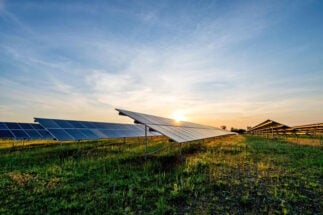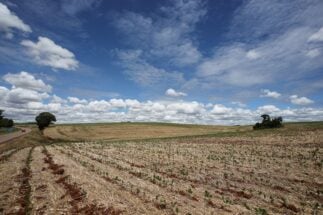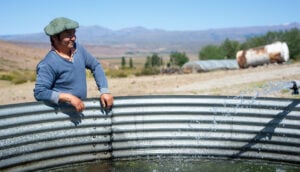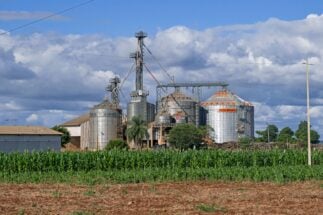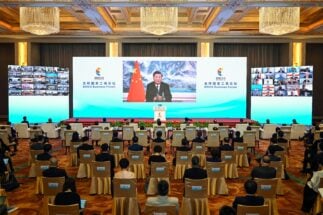Osvaldo lives with his wife and baby in Lambaré, a city in the Greater Asunción area of Paraguay’s capital. Frequent power outages, whether due to intense heat, storms or other reasons, often force him to move to a relative’s house. But constant interruptions have caused losses for his business, and prompted him to buy his own generator.
Osvaldo’s situation is one that many Paraguayans have found themselves in, opting for generators to ensure electricity in their homes or offices. This would not be so unusual were it not for the fact that Paraguay is one of the world’s largest exporters of electricity.
The South American country consumes only 16% of the electricity it produces; the rest is exported as a commodity to countries such as Argentina and Brazil, with whom Paraguay respectively shares the Yacyretá and Itaipú hydroelectric dams. It is also worth mentioning that this energy is sold at lower than the market price due to international agreements, as civil society organisation Base IS highlights.
Paraguay: Hydroelectric exporter, fuelled by firewood
Despite generating and exporting a great deal of hydroelectricity, Paraguay heavily relies on biomass for domestic consumption. “Wood from forest plantations and native forests supplies 51% of households for cooking,” explains Guillermo Achucarro, an environmental engineer specialising in climate change. “The remainder is used by agricultural industries, which find it cheaper to use firewood than to pay for electricity.”
The latest report by the Vice Ministry of Mines and Energy, on the production and consumption of forest biomass for energy, supports the expert’s assertion and highlights the importance of firewood for Paraguay’s domestic energy demand. “The excessive demand for biomass, against scarce supply of sustainable biomass, results in a high consumption of wood from native forest, which indirectly induces a process of degradation of the remaining forests,” the document reads.
Miguel Lovera, a Paraguayan agronomist and PhD in biodiversity and international forestry policy, points out that reliance on fuelwood has a triple impact on the environment: first, in the destruction of primary forests; second, in the clearing of regenerating forests; and finally, in the expansion of monoculture tree plantations, which affect biodiversity and climate cycles.
Dry rivers threaten hydro potential
Although Paraguay’s domestic demand is mostly supplied by biomass, the generation capacity of the country’s three hydroelectric plants – Acaray, Yacyretá and Itaipú – has been considerably impacted by two consecutive years of historic drought along the Paraná River, on which all three are located.

“For the second year in a row, the Paraná River has seen its biggest drop. This has not happened since 1970,” says Achucarro. “And for that to happen two years in a row is definitely not normal.”
The expert points out that this phenomenon is regional, across the La Plata basin, and comes as a consequence of intensive deforestation, especially in the Amazon, with the biome being one of the great sources of water in the Southern Cone.
Due to the low flow, little water has reached the reservoirs of the three power plants, which has considerably reduced production. This water crisis also means the Paraguayan state is receiving less in royalties.
“Hydroelectric plants are not eternal; they have a useful life. The reservoirs gradually fill up with sediment until the hydroelectric plant stops working,” warns engineer Mercedes Canese, a former vice minister of Mines and Energy, adding that hydroelectric production is becoming even less stable in the context of climate crisis.
The engineer explains that the process of sedimentation is accelerated if the basin is not cared for, adding that this is happening due to soybean monocultures on the banks of the Paraná River.
Climate crisis is an energy crisis
“A significant aspect of the climate crisis is how it relates to energy sovereignty, in all its dimensions,” Achucarro points out. “Less water, less energy, it’s as simple as that.”
According to a CAF development bank index, Paraguay is the South American country most vulnerable to climate change, and ranks among the 10 nations at extreme risk in wider Latin America and the Caribbean, due to its low development indicators and an economy dependent on the agricultural sector.
As Paraguay struggles with droughts, floods, increasingly extreme events, a lack of water security and displacement of people, its energy future is not looking rosy either. The Vice Ministry of Mines and Energy has indicated that, as of 2030, energy production will be insufficient to cover domestic demand.
A significant aspect of the climate crisis relates to energy sovereignty. Less water, less energy, it’s as simple as that
It is not only the climate crisis that is complicating these calculations and accelerating the inevitable, as other practices exacerbate the problem. Making matters worse is the intense deforestation in Paraguay, which is affecting the amount of water available to supply its hydroelectric plants.
“Much deforestation takes place to meet the energy demand for fuelwood, which is used in homes and industry. To a lesser extent, biomass is extracted from forest plantations. The less water there is, the less plants grow to meet energy needs,” says Achucarro.
In this context, a cheap and fast alternative for energy supply are forest plantations, but these have a hidden cost that ends up being more onerous. “Forest plantations, used as biomass, destroy native forest in order to meet energy demand,” the expert says.
Lovera illustrates the effect of deforestation on water availability: “As there are fewer forests, there is less recharge of aquifers. And with less recharge of aquifers, there is less flow in the rivers, which is the drainage system for these full aquifers.”
However, full and further studies are still needed to accurately estimate the impact of climate vulnerability on the production of Paraguay’s three hydroelectric plants.
A future of energy shortages?
Engineer Canese reminds us that, every year, domestic demand for energy increases, and in an increasingly adverse climate context, a future scenario of shortages is possible. Héctor Richer and Miguel Fulgencio Rodríguez, former heads of the National Electricity Administration (ANDE), the Paraguayan state-owned energy provider, agree with this prognosis, stating that it is likely that ANDE will have to resort to programmed outages.
Osvaldo believes that, faced with constant power cuts, Paraguayans have no choice but to buy a generator. Disadvantages include noise, pollution and fuel consumption, but he has no choice. He cannot rely on the current quality of service: his income depends on it.
The solution, Osvaldo says, cannot only be an individual one. He believes the Paraguayan government should adopt public policies to improve the distribution network, price and other aspects linked to the efficiency of the service.
A lack of adequate infrastructure is compounded by an energy mix that fails to take advantage of renewable energy sources and the advance of the climate crisis, which promises to exacerbate the problems.
In the not too distant future, one of the world’s largest energy exporters may not be able to turn on the lights.
This article is republished as part of Comunidad Planeta, a project led by Periodistas por el Planeta (PxP) in Latin America, of which Diálogo Chino is a part.

